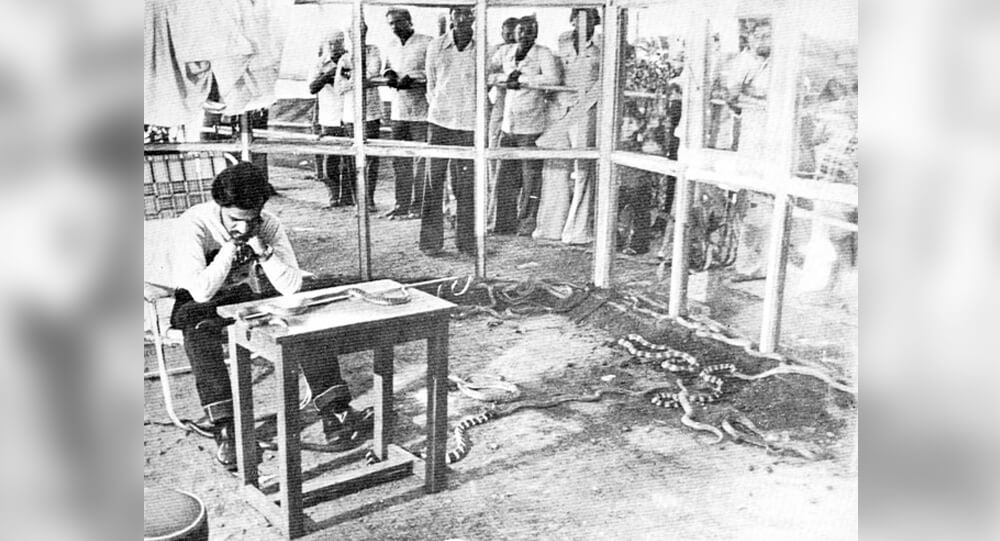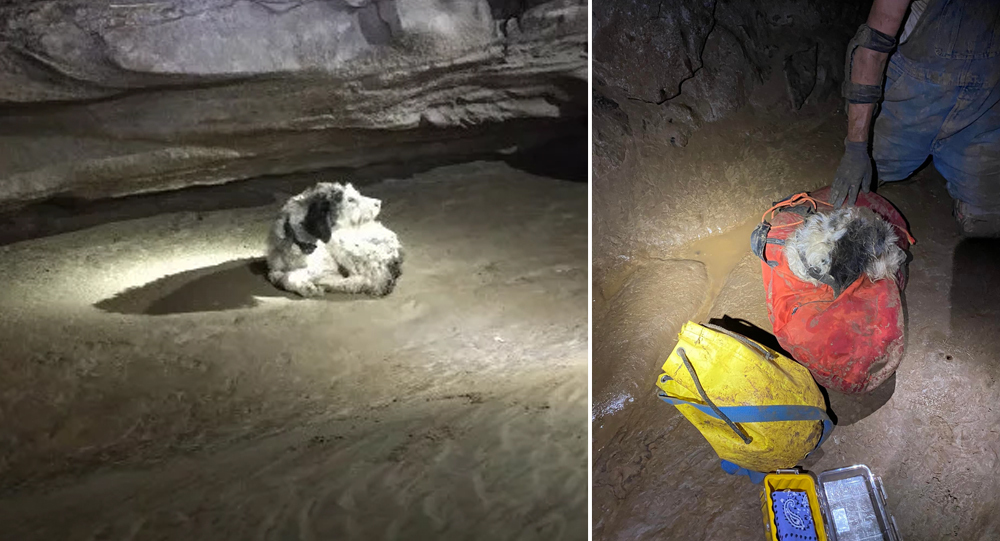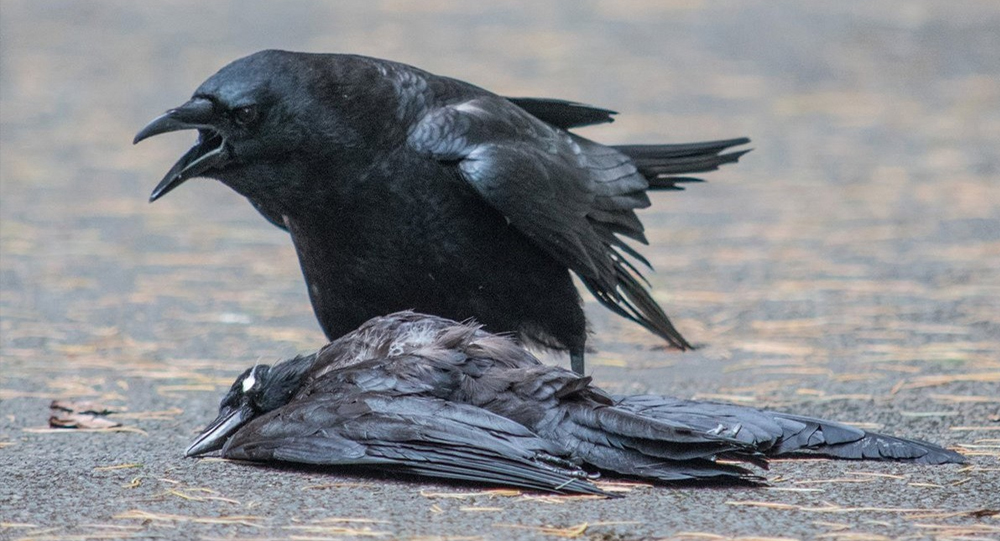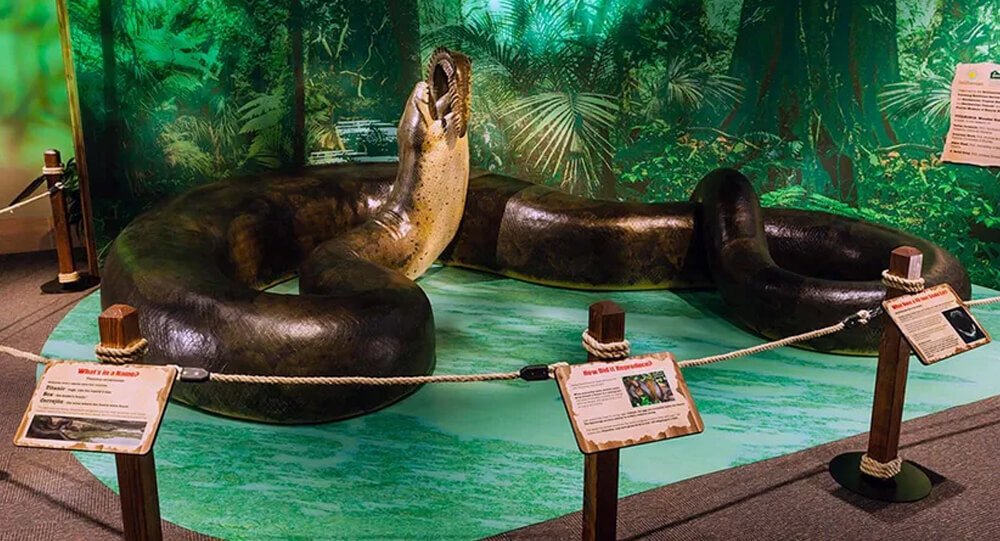
In January 1975, hundreds of snakes unexpectedly appeared from their hibernation tunnels near Haicheng, a city northeast of Beijing, startling Chinese fieldworkers and woodcutters before freezing to death in the snow.
Farmers in the area observed abnormal behavior from livestock at the same time. Horses and cows continually tried to escape their corrals and refused to enter barns. Hens stopped producing eggs for a week while chickens roamed around in a panic. Cats bristled and refused to stay inside while dogs howled day and night.
Many fish were spotted leaping from rivers and lakes, while tigers, deer, and birds were said to have been seen leaving the region.
The water level in backyard wells was also reported to have changed significantly by the locals. Within a few days, scientists started to map telltale changes in the Earth’s magnetic field and ground tilt.
Emergency personnel evacuated the inhabitants of Haicheng on February 3. A few hours later, 90% of the city’s structures were destroyed or severely damaged by an earthquake with a magnitude of 7.3. There were few reported human casualties; thousands of lives had been saved by the prompt warnings.
The scientific process, which has long sought a technique to forecast earthquakes, was excited by the Haicheng event.
The connection between unusual animal behavior and earthquakes has attracted a lot of attention. To prove scientifically what has been maintained in mythology and legend for hundreds of years—those animals can feel approaching temblors—the U.S. Geological Survey initiated three investigations.
Observing captured mice and kangaroo rats in an earthquake-prone area, gathering 1,700 volunteers in seismically active areas to report unusual animal behavior via a telephone hotline, and speaking with locals near five earthquake epicenters were all parts of the three studies carried out in California in the late 1970s. While some odd animal behavior was seen, none of the three experiments could be conclusively concluded.
Don Dupras, an associate geologist for the California Department of Mines and Geology, remarked that an experiment must be repeatable for it to be taken seriously in science. The issue is how to set up a repeatable, controlled experiment given how unpredictable earthquakes are. ”
Researchers from UCLA established a mock outdoor habitat for around 50 pocket mice in the Morongo Valley, some 30 miles north of Palm Springs, as one of many attempts to study animal behavior. Because pocket mice don’t drink water, they were chosen because they were simple to separate. Robert Lindberg, a research biologist at UCLA, explained, “We had one cage above ground and a connected cage buried under the ground.” It was the closest thing we could get to a natural setting.
In addition, several kangaroo rats kept in indoor cages were observed.
The three greatest quakes, which occurred on March 15, 1979, had magnitudes of 5.2, 4.9, and 4.8. Moreover, more than 35 minor quakes were noted. During the stronger quakes, the ground reportedly shifted for up to 20 seconds, according to researchers.
The UCLA researchers wrote, “To our evident delight, considerable, and in some cases dramatic, activity anomalies were documented from the majority of animals in both the indoor and outdoor activities. However, the investigation concluded that the increased activity might have been caused by human interference during feeding time or by a rise in the temperature of the outside air during the spring.
According to Lindberg, “the overall impression I get is that we didn’t have strong evidence of animals acting differently.” “We did have a few pocket mice run above ground right before the quake swarm on March 15 at a time when they are typically in their underground cages. But, that might have been caused by the warmer weather we were having. Sadly, we were unable to establish whether animals could or could not foresee earthquakes.
SRI International from Menlo Park conducted the second Geological Survey research (formerly the Stanford Research Institute). A total of 1,700 volunteers were enlisted in Humboldt County, the San Francisco Bay Area, and Los Angeles County to report unusual animal behavior via a toll-free hotline. The messages were recorded and logged by researchers.
The calls that came in right after an earthquake was detected were rejected, according to Leon Otis, the project’s chief investigator. We believed that previous to the earthquake, reports of strange animal behavior would be more accurate.
13 earthquakes with a Richter scale magnitude greater than 4.0 were registered in the study area over a four-year period. Researchers saw a “significant” spike in calls during seven of the 13 earthquakes. (Reports of fish jumping, dogs howling, ants swarming, general unrest among livestock, and domestic birds biting and killing their young were among some of the incidents.)
Only one instance, though, had dramatic repercussions. In a 30-day period following the magnitude 4.3 Fremont earthquake in 1981, 21 calls to the hotline were made, with an average of one call per day.
“We thought there could be something there, and I still think so. Yet, in the absence of proof, we can only regard the Fremont episode as speculative,” Otis stated.
University of California, Davis hosted the third Geological Survey research. Five earthquakes were studied, and within days after the quakes, residents within less than three miles of the epicenters were questioned about any strange animal behavior they may have seen.
The findings in four of the five incidents were comparable to those at Ovando, Montana, where only one out of 35 people noticed any unusual behavior before an earthquake that measured 4.9. One instance can be found in Willits, Northern California, where 17 out of 50 people interviewed reported seeing strange animal behavior within a week of a 4.7 earthquake.
The three studies had some intriguing findings, despite the fact that their results were inconclusive, according to Otis. “Unfortunately, under the present Government, federal funding for animal and seismic tests has ceased. There are no more planned studies as far as I know.
Several animals have seismic sensory abilities that are significantly superior to those of humans, according to research done in the lab.
For instance, fish have incredibly sensitive otolithic organs in their ears, which are capable of detecting seismic activity that is up to three magnitudes weaker than that observed by humans. This includes the minuscule foreshocks that commonly precede significant earthquakes but are too small to register on the Richter scale.
The ability to detect extremely modest gradients of water displacement that can be brought on by the foreshocks of underwater earthquakes is shared by a variety of fish and amphibians. The ability to detect light electromagnetic fluctuations caused by early earthquake activity may also be shared by catfish, sharks, and rays. Animals that live on the ground may also experience foreshocks before people do.
Additionally, some scientists postulate that a variety of animals may include microscopic magnetite crystals in their brains that are vulnerable to seismic changes in the Earth’s magnetic fields, which are the predecessors to the majority of earthquakes.
Yet for the most part, scientists have given up on using animals as earthquake predictors. There are no longer any active studies involving animals and earthquakes. Almost everyone has given up on the idea of animals, including China, according to Dupras of the California Department of Mines and Geology.
Following the shaker on October 1, a haphazard examination of the Los Angeles Zoo produced similarly conflicting data.
The day before the earthquake, none of our keepers saw any strange behavior, according to Laura LaMarca, the zoo’s curator of education. “Our gorillas refused to return to their holding cage after the main shock and before the aftershocks. Yet, in my opinion, that was just common sense and not predictive behavior.

How European Rabbits Took over Australia
In 1859, wealthy settler Thomas Austin released 13 wild rabbits on his Australian estate. By 1920, their population grew to 10 billion.

Why the Brooklyn Bridge Was Once Crossed by 17 Camels and 21 Elephants
On May 30, 1883, a rumor that the Brooklyn Bridge was going to collapse caused a stampede, which killed at least at twleve people. To prove the bridge was safe, P.T. Barnum led a parade of 21 elephants over it.

Pierre Brassau: The chimpanzee painter who deceived the avant-garde world
Abstract paintings by a previously unknown artist “Pierre Brassau” were exhibited at a gallery in Sweden, earning praise for his “powerful brushstrokes” and the “delicacy of a ballet dancer”. None knew that Pierre Brassau was actually a 4 year old chimp from the local zoo.

A one-eyed Vancouver fish receives a fake eye so that other fish will not bully him
A fish whose eye was removed due to cataract was bullied by other fish at the Vancouver Aquarium. So the vets fitted the fish with a prosthetic eye to fool the other fishes.

How Switzerland ended rabies epidemic by air-dropped vaccinated chicken heads
A rabies epidemic struck foxes in Switzerland in the 1960s. The government wanted to vaccinate foxes against rabies, but manual vaccination was difficult and expensive. Instead, they began dropping vaccinated chicken heads across the countryside for the foxes to consume, and the rabies vanished.

The Incredible Story of Sergeant Stubby, the Dog Who Became a War Hero
Sergeant Stubby was not just an ordinary dog—he was an extraordinary war hero who served alongside American troops during World War I. From catching a German soldier by his pants to alerting soldiers of mustard gas attacks and locating wounded comrades, Stubby’s bravery saved countless lives in the trenches. This article chronicles the inspiring journey of the stray dog who became the most decorated animal of the Great War and remains a beloved symbol of courage and loyalty.

Photos of dogs who were stung by bees yet remained adorable
Flies are sky raisins, aren't bees jalapeno sky raisins as well? Please note: you are a terrible person if you laugh at this gallery, just kidding. Enjoy the photos of dogs who were stung by bees yet remained adorable.

The story of a man who spent 72 hours with 72 venomous snakes to prove they only bite when provoked
In the 1980s, an Indian man spent 72 hours in a glass cabin with 72 snakes, some of which were extremely venomous. His aim was to prove that snakes only attack when provoked. Remarkably, he was not bitten once in those 72 hours and even set a Guinness World Record in the process.

The story of Bill Haast, who lived to be 100 despite his extensive snake venom injections
Bill Haast immunized himself by injecting snake venom into his blood for several years. He holds the Guinness World Record for surviving the most lethal snake bites, having been bitten over 172 times. Bill became known as "Snake Man" around the world and lived for over 100 years.

The 440-pound bear named Wojtek and his World War II battle against the Nazis
Polish troops raised an orphaned bear cub during WWII. He enjoyed drinking beer, and was trained to salute. He became officially enlisted as a member of the forces, and helped carry artillery during battle.

The story of The chicken that lived for 18 months without a head
Mike the Headless Chicken was a rooster whose head was accidentally chopped off but miraculously survived. This is due to most of the brain stem being left intact. He was fed using a special tube that delivered food directly into his esophagus. Despite his lack of a head, he lived for 18 months, gaining worldwide fame before ultimately choking on a kernel of corn during one of his tours, in a Motel in Fruita, Colorado.

13-year-old dog missing for two months found alive in a cave.
On Aug 6, 2022, A group of Missouri cave explorers accidentally found and helped rescue a senior dog that had been missing for two months. It is unclear how long the dog was in the cave or how it managed to survive.

10 Rarest and Albino animals you haven’t seen
For centuries, people have been fascinated and enchanted by the ghostly appearances of abnormally white animals. People have loved albinos and other unusually white animals so much that they may be helping to increase their numbers, despite the difficulties these animals face in the wild. While these unusual animals did not win the genetic lottery, they have persevered in the face of adversity.

9 Reasons Crows Are Smarter Than You Think
Crows have the intelligence of a 7-year-old human, making them one of the smartest non-primate animals on the planet. They use tools, have a long-term memory that includes facial recognition, and comprehend analogy.

The Evolution of Flight: From Dinosaurs to Birds – A Journey Through Time and Science
Flight is one of nature’s most remarkable adaptations, but its origins trace back millions of years before modern birds took to the skies. Emerging from theropod dinosaurs during the Jurassic period, birds evolved feathers, wings, and lightweight bodies that enabled powered flight. This detailed narrative explores the fascinating evolutionary path from ground-dwelling dinosaurs to the aerial masters of today, blending science, intriguing fossil finds, and surprising trivia about our feathered ancestors.

Remembering Alex: The African Grey Parrots Final Message
"You be good, I love you. See you tomorrow" Parrot's last words to her caretaker. Alex (1976 – September 6, 2007) was an African Grey Parrot and the subject of a thirty-year (1977–2007) experiment by animal psychologist Irene Pepperberg, initially at the University of Arizona and later at Harvard University and Brandeis University. Pepperberg bought Alex in a regular pet shop when he was about one year old.

Are Octopus Intelligent? A Look Inside an Octopus's Brain
Octopuses are extremely intelligent. It is the only invertebrate capable of emotion, empathy, cognitive function, self-awareness, personality, and even interpersonal relationships. Some believe that if humans did not exist, octopi would eventually take our place as the dominant life form on Earth.

Why Crows Hold Funerals for Their Dead
Crows are far more than noisy backyard birds; they engage in peculiar, ritualistic behaviors when one of their own dies. Known as “crow funerals,” these gatherings involve groups of crows circling, calling, and sometimes even interacting physically with the deceased in ways that stump scientists and captivate bird watchers. What drives this strange behavior? New research reveals it’s a complex mix of learning, social bonding, and survival instinct wrapped in an enigmatic ritual.

Bear, Tiger, And Lion Became Friends For Life
In 2001, a Bear, Tiger, And Lion cub where found abandoned in a drug dealer's basement. They were soon adopted by a sanctuary and lived together ever since.

Jack the Baboon operated a railroad, earned a living, and never made a mistake
A baboon worked as a signalman for the railroad in the late 1800s. He never made a mistake and worked for the railroad until the day he died.

Kipekee, the world's only spotless giraffe, was born at Brights Zoo
The world's only spotless giraffe was born at a zoo in the United States. The giraffe born without spots on July 31 is the only one of her kind on Earth.

A man travels for hours daily through a drought to provide water for wild animals.
This man travels throughout Kenya bringing thirsty animals thousands of litres of water. Patrick Kilonzo Mwalua regularly travels to the Tsavo, where extreme drought is endangering the lives of elephants, buffalo, zebras, and antelope. He promises to keep giving out water every week until it starts to rain in the hopes that getting the word out will lead to a long-term fix.

Megamouth Shark And Her Babies Found Dead In The Philippines
Filipino zoologists have recorded a pregnant megamouth shark for the first time ever since the rare aquatic specie was discovered in 1974.

A Super Cat With Excessively Large Muscles Goes Viral Due To A Rare Condition
The cat suffers from Myostatin-related muscular hypertrophy, which leads it to grow muscle mass while not desiring to.

Titanoboa cerrejonensis, fossils of the world’s largest species of snake
In 2009 in a coal mine of Columbia, scientists discovered fossils of the world’s largest species of snake. The species is called “Titanoboa cerrejonensis,“and it is from around 60 million years ago. It would have had measured about 48 feet long and weighed about 2,500 pounds


























